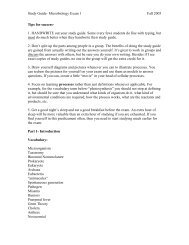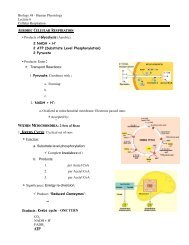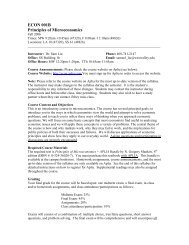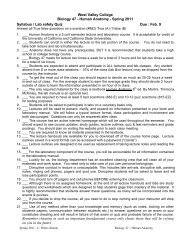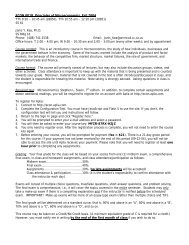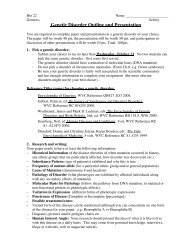Battle of the Sexes
Battle of the Sexes
Battle of the Sexes
Create successful ePaper yourself
Turn your PDF publications into a flip-book with our unique Google optimized e-Paper software.
OURTESY OF THE PROCEEDINGS OF THE NATIONAL ACADEMY OF SCIENCES<br />
Fish Study Finds That Male<br />
Mate Choice Matters<br />
Biologists generally agree that female choosiness drives <strong>the</strong> males <strong>of</strong> <strong>the</strong>ir species to ever-greater heights <strong>of</strong> showmanship,<br />
from having brighter fea<strong>the</strong>rs and more sprawling antlers to driving faster cars. Now, in a striking validation <strong>of</strong> <strong>the</strong> cosmetics<br />
and fashion industries, Trond Amundsen and Elisabet Forsgren at Sweden’s Goteborg University demonstrate, at least in fi sh,<br />
that male choice matters too.<br />
Amundsen and Forsgren, who published <strong>the</strong>ir results in <strong>the</strong> october 16, 2004 Proceedings <strong>of</strong> <strong>the</strong> National Academy <strong>of</strong><br />
Sciences, found that male two-spotted gobies stuck in a partitioned tank between two contrasting females—one with a bright<br />
yellow-orange belly, <strong>the</strong> o<strong>the</strong>r drab—spent twice as much time in <strong>the</strong> side <strong>of</strong> <strong>the</strong>ir chamber next to <strong>the</strong> fl ashier female, even if<br />
<strong>the</strong> color was markered on. They were also four times more likely to display <strong>the</strong>ir willingness to mate—by shivering up close<br />
to <strong>the</strong> female or undulating toward <strong>the</strong> nest—for <strong>the</strong> more brightly colored female fi sh. These results, <strong>the</strong> authors write, “suggest<br />
that <strong>the</strong> colorful belly <strong>of</strong> female two-spotted gobies has evolved, at least partly, as a response to male mate choice.”<br />
But male gobies aren’t just interested in beauty. A female’s color, which comes from carotenoids in her eggs and to a lesser<br />
extent her skin, may indicate to <strong>the</strong> male <strong>the</strong> quality <strong>of</strong> her eggs, <strong>the</strong> authors note. Males gobies are far outnumbered by<br />
females at <strong>the</strong> end <strong>of</strong> <strong>the</strong> mating season and nurture <strong>the</strong> eggs by <strong>the</strong>mselves, so <strong>the</strong>y have a strong incentive to recoup <strong>the</strong>ir<br />
investment by choosing a mate who produces eggs more likely to survive.<br />
The authors point out that mate choice on <strong>the</strong> part <strong>of</strong> male animals is relatively widespread. For that reason, <strong>the</strong>y write, “we<br />
suggest that more attention be directed at <strong>the</strong> largely unstudied phenomenon <strong>of</strong> female ‘beauty’ in fi sh and o<strong>the</strong>r animals.”<br />
—JR Minkel<br />
Female Antelopes Fight for Fine Mates<br />
Humans aren’t <strong>the</strong> only mammals with a swinging singles scene. Nine<br />
o<strong>the</strong>r species engage in a process known as lekking, whereby bachelor<br />
males congregate in certain areas during <strong>the</strong> mating season looking<br />
for love. And according to a report published June 25, 2002 in <strong>the</strong><br />
Proceedings <strong>of</strong> National Academy <strong>of</strong> Sciences, females may be more<br />
aggressive about landing eligible males than previously thought.<br />
Earlier work had shown that in bird species that engage in lekking,<br />
females <strong>of</strong>ten compete for preferred males. For mammals that form<br />
leks, however, scientists thought that factors o<strong>the</strong>r than mate choice<br />
attracted females to <strong>the</strong> party. Now <strong>the</strong> new study, conducted by Jacob<br />
Bro-Jørgensen <strong>of</strong> <strong>the</strong> Zoological Society <strong>of</strong> London, reveals that in <strong>the</strong> case <strong>of</strong> topi antelopes, leks actually have poorer food<br />
supplies, higher rates <strong>of</strong> predation and higher levels <strong>of</strong> harassment for females than surrounding areas do. But <strong>the</strong> opportunity<br />
to mate with desirable males, it seems, <strong>of</strong>fsets <strong>the</strong>se drawbacks. After two years <strong>of</strong> studying topi populations on <strong>the</strong> Serengeti<br />
and Masai Mara plains, Bro-Jørgenson reports that he witnessed competitive aggression between females (see image) over socalled<br />
central males, which tend to be larger and older and to have darker facemasks than <strong>the</strong>ir peers. In fact, some females<br />
even went so far as to disrupt matings that were already in progress. Bro-Jørgenson concludes that “<strong>the</strong> fi nding suggests that<br />
<strong>the</strong> forces leading to lek evolution in mammals and birds may be more similar than previously acknowledged.” —Sarah<br />
Graham<br />
Birds <strong>of</strong> Different Fea<strong>the</strong>rs Pair Toge<strong>the</strong>r<br />
For most animals, selecting a mate from a different species is risky business. More <strong>of</strong>ten than not, even if <strong>the</strong> <strong>of</strong>fspring are<br />
viable, <strong>the</strong>y cannot <strong>the</strong>mselves reproduce, as in <strong>the</strong> classic case <strong>of</strong> mules. But fi ndings described in <strong>the</strong> May 3, 2001 Nature<br />
reveal that some birds manage to avoid <strong>the</strong> costs <strong>of</strong> hybridization. In fact, such interspecies pairing can even be <strong>the</strong> female’s<br />
best bet.<br />
Ben Sheldon <strong>of</strong> <strong>the</strong> University <strong>of</strong> Oxford and his colleagues studied hybridization between two closely related species, pied<br />
fl ycatchers and collared fl ycatchers. Though males <strong>of</strong> <strong>the</strong> two species clearly differ in <strong>the</strong>ir plumage and songs, female col-<br />
5 SCIENTIFIC AMERICAN EXCLUSIVE ONLINE ISSUE JANUARY 2005<br />
COPYRIGHT 2005 SCIENTIFIC AMERICAN, INC.



